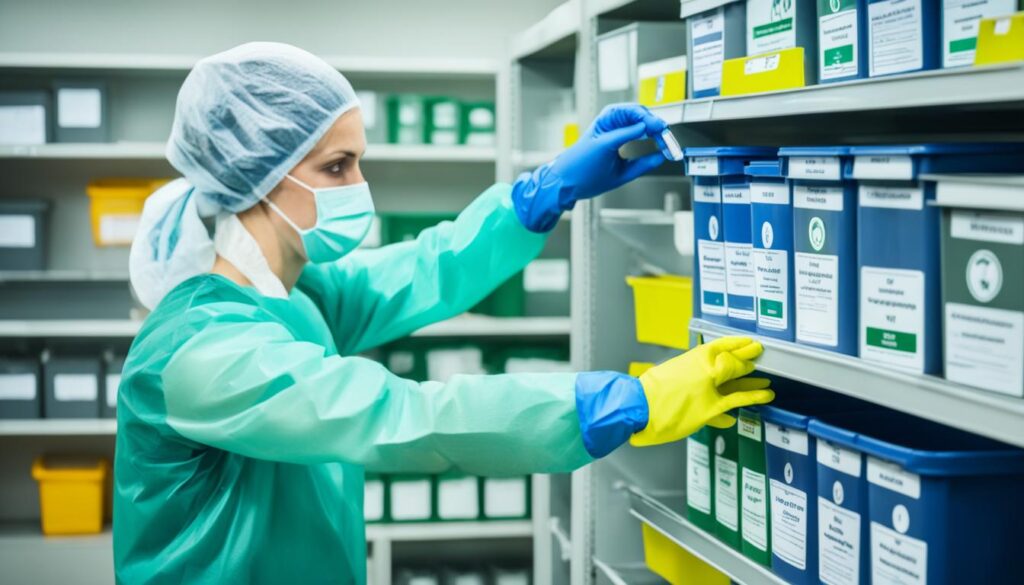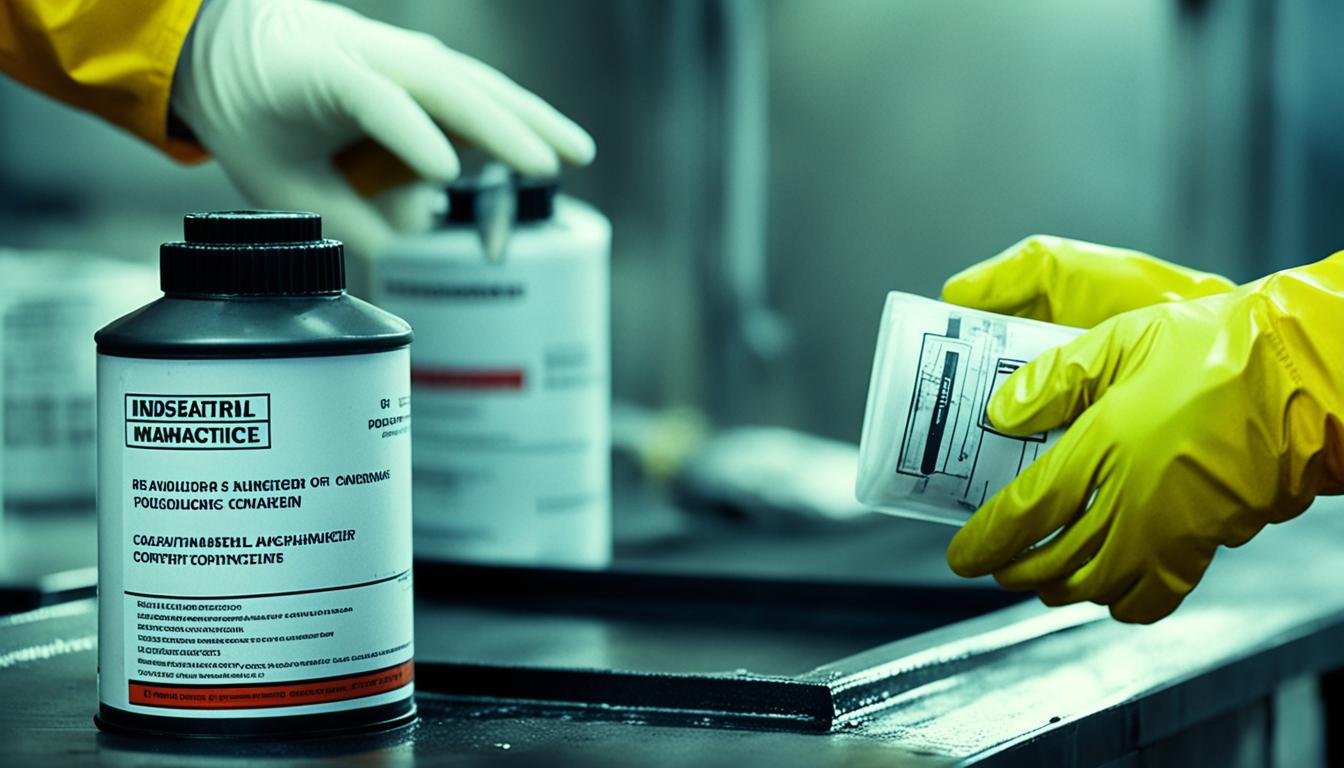Safe Handling of Hazardous Substances Tips
Greetings, fellow readers! Today, we embark on an important journey to explore the realms of workplace safety. In particular, we will delve into the critical topic of handling hazardous substances. Our collective safety depends on our understanding and implementation of safe handling practices. By equipping ourselves with the knowledge and guidelines, we can protect not only ourselves but also our colleagues from potential harm. So, let us venture forth together and unlock the secrets of safe hazardous substance handling.
Key Takeaways:
- It is crucial to read and follow the instructions on product labels for safe handling of hazardous substances.
- Proper storage and disposal of hazardous materials are essential preventive measures.
- Understanding the hazards associated with specific substances allows us to take appropriate precautions.
- Compliance with safety regulations, such as COSHH, ensures the implementation of necessary control measures.
- Personal Protective Equipment (PPE) plays a vital role in minimizing risks during substance handling.
Understanding the Hazards
When it comes to handling hazardous materials, knowledge is power. Understanding the specific characteristics and dangers associated with these substances is crucial for taking the necessary safety precautions. Whether it’s in the workplace or at home, being aware of the potential hazards helps us minimize risks and protect ourselves and those around us.
One of the first steps towards safety is reading product labels and ingredient lists. These provide valuable information about the hazardous substances present in a product and any safety precautions we should take. Make it a habit to thoroughly review these labels before using or handling any potentially dangerous materials.
“Understanding the hazards associated with hazardous substances allows us to take appropriate precautions and minimize the risks. Reading labels and knowing how to handle, store, and dispose of these materials safely are vital steps in protecting ourselves and the environment.”
Additionally, familiarizing ourselves with the proper handling, storage, and disposal practices is essential. Take the time to educate yourself about the specific guidelines and regulations related to hazardous materials. By doing so, you can develop safe habits and ensure that you are following best practices to prevent accidents and mitigate any potential harm.
Below, we have provided a summary of key safety precautions and guidelines to keep in mind when dealing with hazardous materials:
- Always wear appropriate personal protective equipment (PPE) when handling hazardous substances. This may include gloves, goggles, or respiratory protection, depending on the nature of the hazards involved.
- Avoid direct contact with hazardous materials whenever possible. If contact occurs, follow proper decontamination procedures.
- Store hazardous materials in designated areas that are secure and properly labeled. Use appropriate storage containers to prevent leaks or spills.
- Never mix different hazardous substances unless explicitly instructed to do so by the manufacturer.
- Dispose of hazardous materials according to the recommended procedures and regulations. Improper disposal can have serious consequences for both human health and the environment.
By understanding the hazards associated with hazardous substances and practicing proper safety precautions, we can protect ourselves, our colleagues, and the environment from potential harm. Remember, safety should always be our top priority.
In Summary
Understanding the characteristics and dangers of hazardous substances is fundamental to ensuring safety. By reading product labels, following recommended handling procedures, and utilizing appropriate personal protective equipment, we can minimize the risks associated with handling hazardous materials. Let’s always prioritize safety and take the necessary precautions to protect ourselves and others.
https://www.youtube.com/watch?v=aG6TEWmdN28
Compliance with Safety Regulations
Compliance with safety regulations is paramount when it comes to handling hazardous substances in the workplace. By adhering to these regulations, we can ensure the well-being and safety of all employees.
The Control of Substances Hazardous to Health (COSHH) regulations in the UK play a crucial role in preventing exposure to hazardous substances and maintaining adequate control measures. These regulations encompass a range of guidelines and procedures aimed at minimizing the risks associated with working with hazardous materials.
To comply with safety regulations, it is essential to use appropriate control equipment and implement safe procedures when handling hazardous substances. This includes providing workers with the necessary personal protective equipment (PPE) and ensuring its proper usage. By equipping employees with the right protective gear, we can mitigate potential risks and hazards.
Additionally, compliance with safety regulations involves promoting worker behavior that aligns with the established guidelines. This can be achieved through comprehensive training programs that educate employees about the hazardous materials they may encounter in the workplace and the procedures for handling them safely.
“Compliance with safety regulations ensures that we minimize the risks associated with hazardous substances and create a safer working environment for everyone involved.”
Promoting a Culture of Safety
Creating a culture of safety requires more than just complying with regulations—it involves fostering an atmosphere where everyone is accountable for adhering to workplace safety guidelines. By consistently following safety procedures and promoting awareness, we can prioritize the well-being of all employees.
Overview of Safety Regulations
| Regulation | Description |
|---|---|
| Control of Substances Hazardous to Health (COSHH) regulations | UK regulations aimed at preventing exposure to hazardous substances and ensuring the implementation of adequate control measures. |
| Personal Protective Equipment (PPE) requirements | Guidelines regarding the appropriate use of protective equipment to minimize the risks associated with handling hazardous substances. |
| Safe handling and storage procedures | Procedures that establish best practices for handling, storing, and disposing of hazardous materials in the workplace. |
| Employee training and awareness programs | Initiatives aimed at educating employees about the potential hazards of hazardous substances and the measures they should follow to ensure their safety. |
By adhering to safety regulations and implementing workplace safety guidelines, we can create a secure environment where the handling of hazardous substances is done with utmost care and precaution.

Personal Protective Equipment and Proper Handling Practices
When it comes to the safe handling of hazardous substances, personal protective equipment (PPE) plays a crucial role. PPE acts as a barrier between us and the potentially harmful effects of these substances, protecting our health and well-being. By using the appropriate PPE and following proper handling practices, we can effectively manage the risks associated with hazardous materials.
Personal Protective Equipment (PPE)
Using the right PPE is essential to ensure our safety when handling hazardous substances. The specific types of PPE required may vary depending on the nature of the substances being dealt with. Some common examples of PPE include:
- Gloves: Protect hands from chemical contact and exposure
- Goggles: Shield eyes from splashes, fumes, or airborne particles
- Respiratory Protection: Filter out harmful particles or fumes in the air
It is important to carefully select the appropriate PPE based on the hazards present. Consult the Safety Data Sheet (SDS) of the substance to identify the recommended PPE for handling it safely.
Maintenance and Replacement
To ensure the effectiveness of PPE, it is crucial to maintain and replace it as needed. Regular inspection of PPE for any signs of wear, damage, or degradation is essential. If any defects or compromises are detected, the equipment should be replaced immediately to avoid any potential risks.
Proper Handling Practices
In addition to using PPE, following proper handling practices is vital for minimizing the risks associated with hazardous substances. Some key practices to keep in mind include:
- Avoid Mixing or Combining: Unless it is safe to do so, avoid mixing or combining hazardous materials. Unauthorized mixing can lead to unexpected reactions and pose significant dangers.
- Caution with Flammable Liquids: When transferring flammable liquids, take precautions to prevent the buildup of static electricity, which could trigger a fire or explosion.
- Proper Substance Management: Adhere to proper substance management protocols, including labeling, storing, and disposing of hazardous materials according to regulations.
Remember, our safety is in our hands. By using the appropriate Personal Protective Equipment (PPE) and following proper handling practices, we can protect ourselves and minimize the risks associated with hazardous substances.

Storage and Disposal of Hazardous Materials
Proper storage of hazardous materials is crucial to maintain a safe working environment and protect both employees and the surrounding community. Implementing appropriate storage procedures ensures that accidents are minimized and risks are effectively managed.
When storing hazardous materials, it is essential to consider their specific characteristics and potential for harm. Flammable chemicals, for example, should be stored in cool, dry areas away from heat sources and direct sunlight. This helps prevent the risk of ignition and potential for fire. Separating incompatible materials is also vital to avoid chemical reactions that could lead to dangerous situations.
To maintain consistency and safety, hazardous materials must be stored in approved containers designed for their specific properties. These containers should be suitable for the substance they hold and have secure lids that are always kept tightly closed. By doing so, the potential for leaks or spills is minimized, reducing the risk of exposure to these hazardous substances.
Proper disposal of hazardous waste is equally critical in order to protect the environment and ensure the health and safety of individuals. It is essential to follow approved procedures and never pour hazardous substances down sewers or drains. This prevents contamination of water sources and potential harm to ecosystems and public health.
By adhering to hazardous waste management guidelines and proper disposal practices, we can mitigate the negative impact of these materials and contribute to a healthier, safer environment for all.

Proper Storage and Disposal Procedures for Hazardous Materials
| Storage Procedures | Disposal Procedures |
|---|---|
| Store flammable chemicals in cool, dry areas away from heat and sunlight. | Follow approved procedures for disposal and never pour hazardous substances down sewers or drains. |
| Separate incompatible materials to prevent chemical reactions. | Dispose of hazardous waste in designated containers and collection points. |
| Use approved containers with secure lids to prevent leaks and spills. | Properly label containers and waste packaging for identification and safer handling. |
Conclusion
Handling hazardous substances requires meticulous attention to safety regulations and procedures. By understanding the hazards associated with these materials, using appropriate personal protective equipment (PPE), and following safe handling practices, we can effectively minimize the risks and ensure workplace safety.
Compliance with safety regulations is of utmost importance when it comes to handling hazardous substances. Adhering to chemical safety protocols, workplace safety guidelines, and the Control of Substances Hazardous to Health (COSHH) regulations in the UK is crucial for protecting employees and preventing accidents.
Proper storage and disposal of hazardous materials also play a significant role in maintaining workplace safety. By following the recommended storage procedures and ensuring the appropriate disposal of hazardous waste, we can prevent environmental contamination and protect both workers and the surrounding ecosystem.
In conclusion, by prioritizing hazardous substance handling and implementing stringent safety measures, including the use of personal protective equipment, compliance with safety regulations, and proper storage and disposal techniques, we can create a safer work environment. By fostering a culture of workplace safety and responsibility, we can protect the well-being of employees and continue to prevent accidents or harm caused by hazardous substances.
FAQ
How can I safely handle hazardous substances?
To safely handle hazardous substances, it is important to read and follow the instructions on product labels. Use protective equipment, such as gloves and goggles, when necessary. Follow proper handling practices, such as not mixing or combining hazardous materials unless it is safe to do so.
What should I do if I come into contact with a hazardous substance?
If you come into contact with a hazardous substance, immediately rinse the affected area with water. Remove contaminated clothing and seek medical attention if necessary.
How can I ensure the proper storage of hazardous materials?
Proper storage of hazardous materials is crucial for safety. Store flammable chemicals in cool, dry places away from heat and sunlight. Separate incompatible materials and ensure they are stored in approved containers with securely closed lids.
How should I dispose of hazardous substances?
Always follow approved procedures for the disposal of hazardous substances. Never pour them down sewers or drains, as this can harm the environment. Instead, dispose of them in designated hazardous waste disposal areas.
What are the safety regulations for handling hazardous substances?
Compliance with safety regulations, such as the Control of Substances Hazardous to Health (COSHH) regulations, is crucial. These regulations aim to prevent exposure to hazardous substances and ensure proper control measures are in place. It is important for employers to provide training and information about hazardous materials to employees.
What personal protective equipment should I use when handling hazardous substances?
The personal protective equipment required may vary depending on the specific hazards involved. However, common types of PPE include gloves, goggles, and respiratory protection. It is important to use the appropriate PPE and properly maintain and replace it as needed.
How can I minimize the risks associated with hazardous substances?
Understanding the hazards of the substances you come into contact with is key to taking appropriate precautions. By following safety guidelines, using proper protective equipment, and implementing safe handling practices, you can minimize the risks associated with hazardous substances in the workplace.






